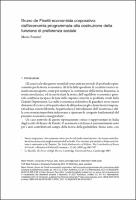Chapter Bruno de Finetti economista corporativo: dall’economia programmata alla costruzione della funzione di preferenza sociale
| dc.contributor.author | POMINI, Mario | |
| dc.date.accessioned | 2022-06-01T12:27:15Z | |
| dc.date.available | 2022-06-01T12:27:15Z | |
| dc.date.issued | 2021 | |
| dc.identifier | ONIX_20220601_9788855184557_712 | |
| dc.identifier.issn | 2704-5919 | |
| dc.identifier.uri | https://library.oapen.org/handle/20.500.12657/56528 | |
| dc.description.abstract | Bruno de Finetti (1906-1985) is well known as the founder of the subjective theory of probability. Less known, with a few exceptions, is his contribution to economic theory during the early stage of his scientific career. In the second half of the 1930s, de Finetti was passionately involved in the field of welfare economics. To provide a theoretical framework for evaluating social welfare and to help in designing public policies, he developed a new mathematical tool: the theory of simultaneous maxima. Using this analytical approach, he also advanced the idea of a social welfare function, albeit quite different from the one introduced in 1938 by Abram Bergson, reflecting the debate on the economic planning among Italian economists. | |
| dc.language | Italian | |
| dc.relation.ispartofseries | Studi e saggi | |
| dc.subject.other | Bruno de Finetti | |
| dc.subject.other | Mathematical economics | |
| dc.subject.other | History of welfare theory | |
| dc.title | Chapter Bruno de Finetti economista corporativo: dall’economia programmata alla costruzione della funzione di preferenza sociale | |
| dc.type | chapter | |
| oapen.identifier.doi | 10.36253/978-88-5518-455-7.08 | |
| oapen.relation.isPublishedBy | bf65d21a-78e5-4ba2-983a-dbfa90962870 | |
| oapen.relation.isbn | 9788855184557 | |
| oapen.series.number | 227 | |
| oapen.pages | 16 | |
| oapen.place.publication | Florence |

